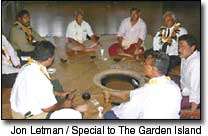LIHU‘E — One recent breezy Sunday afternoon I caught up with members of Kaua‘i’s Tongan community at the Lihue United Church where zippy youngsters gathered to practice singing before their weekly services began. Next door to the main chapel in
LIHU‘E — One recent breezy Sunday afternoon I caught up with members of Kaua‘i’s Tongan community at the Lihue United Church where zippy youngsters gathered to practice singing before their weekly services began. Next door to the main chapel in the 82-year-old lava rock Parish Hall, five Tongan men sat in a circle on a well-worn lau hala mat while a young woman ladled murky kava into coconut shells and passed them around.
Stammering, I began, “I uh…I am looking for a Tongan.”
There was no immediate reply from the five sturdy men dressed in sarong-like wrap arounds called tupenu, but then a stout man with a walrus mustache and brilliant yellow (hala), green (ti) and white (pua keni keni) lei asked which Tongan I was looking for.
Any Tongan, I replied, explaining that I wanted to learn more about Kaua‘i’s Tongan community and had a few questions.
Holding an empty kava bowl, the man motioned for me to enter the hall and join them on their lau hala mat. Slipping off my slippers, I stepped into the circle of Tongan fathers and was immediately handed a bowl of kava which I accepted, sipping the muddy thin brown drink that is favored across Polynesia as an aid to communication and relaxation. Traditionally made from the masticated roots of kava plants (Piper methysticum) mixed with coconut milk or water, kava is ordinarily drunk only by men in Tonga.
My host, Tumua Masaniai announced that today was Tongan Father’s Day (always the first Sunday after Mother’s Day) and as such, the fathers had been given leis.
Speaking later in the afternoon, other members of the congregation explained that there are two Tongan church services held in Kaua‘i — the Lihue United Church and the Siasi Tonga Tau‘ataina (Free Tongan) church in Kapa‘a. Tongans first started to come to Kaua‘i in the 1980s and today still number less than one hundred. Larger Tongan communities can be found in Honolulu, Maui, California, New York, London and in Japan.
Tumua, who today runs his own contracting company, lived in Honolulu for seven years before moving to Kaua‘i fourteen years ago. Many Tongan families who came to Kaua‘i seeking economic opportunities have at least one male family member in the construction business.
The Friendly Islands, as Tonga is known, are governed by King Taufa‘ahau Tupou IV. Tonga is comprised of about 170 islands in three major groups with a land area of only 277 square miles. Tonga’s population of 110,000 live mostly on or near the main island Tongatapu, home to the capital city Nuku‘alofa.
Located south of Samoa, east of Fiji, Tonga resembles Kaua‘i in terms of climate and temperament, according to members of the Lihue United congregation. Linguistically, Tongan has a number of words similar to Hawaiian: loloa (long), langi (sky), fefine (woman), mo‘unga (mountain) and uli uli (black).
With no Tongan schools or community center on Kaua‘i, Tongan children learn their language, culture and customs at home and church which both playing a vital role in educating, socializing and maintaining links to Tongan culture. The congregation of the Lihue United Church, which welcomed its new associate pastor Reverend Solomone ‘Ulu‘ave at the beginning of July, gathers three times weekly, often holding fund raising events to support family and friends in Hawai‘i and Tonga.
Recently members of the community gathered for the Tongan celebration Fakame or “White Sunday” when children take over the duties of reading hymns and scripture verses. Children also perform skits after which everyone enjoys Tongan dishes like lu pulu (similar to beef lau lau) and faikakai, a Tongan desert made with flour and mei (breadfruit). During holidays, Tongan women where colorful puletaha, a kind of two-piece dress often worn to church or special events. Men look sharp in shirt sleeves, neck ties and black and maroon tupenu which they adorn with hand woven taovala, a broad sash made of pandanus leaves which is worn as a sign of respect and honor.
Women wear a similar article called a kiekie, which may also be made of lau hala or fau (hau) bark.
Tongans greet each other with a robust “malo e lelei” which translates as “fine greetings” and bid farewell saying “nofoa” to which the response is “alua.”


